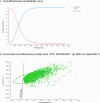Cost-Effectiveness of a Workplace-Based Hypertension Management Program in Real-World Practice in the Kailuan Study
- PMID: 38563379
- PMCID: PMC11262526
- DOI: 10.1161/JAHA.123.031578
Cost-Effectiveness of a Workplace-Based Hypertension Management Program in Real-World Practice in the Kailuan Study
Abstract
Background: In 2009, a workplace-based hypertension management program was launched among men with hypertension in the Kailuan study. This program involved monitoring blood pressure semimonthly, providing free antihypertensive medications, and offering personalized health consultations. However, the cost-effectiveness of this program remains unclear.
Methods and results: This analysis included 12 240 participants, with 6120 in each of the management and control groups. Using a microsimulation model derived from 10-year follow-up data, we estimated costs, quality-adjusted life years (QALYs), life-years, and incremental cost-effectiveness ratios (ICERs) for workplace-based management compared with routine care in both the study period and over a lifetime. Analyses are conducted from the societal perspective. Over the 10-year follow-up, patients in the management group experienced an average gain of 0.06 QALYs with associated incremental costs of $633.17 (4366.85 RMB). Projecting over a lifetime, the management group was estimated to increase by 0.88 QALYs or 0.92 life-years compared with the control group, with an incremental cost of $1638.64 (11 301.37 RMB). This results in an incremental cost-effectiveness ratio of $1855.47 per QALY gained and $1780.27 per life-year gained, respectively, when comparing workplace-based management with routine care. In probabilistic sensitivity analyses, with a threshold willingness-to-pay of $30 765 per QALY (3 times 2019 gross domestic product per capita), the management group showed a 100% likelihood of being cost-effective in 10 000 samples.
Conclusions: Workplace-based management, compared with routine care for Chinese men with hypertension, could be cost-effective both during the study period and over a lifetime, and might be considered in working populations in China and elsewhere.
Keywords: blood pressure; economic evaluation; health consultation; hypertension; workplace‐based.
Figures


Similar articles
-
Cost-effectiveness of Intensive vs Standard Blood Pressure Control Among Older Patients With Hypertension.JAMA Netw Open. 2023 Feb 1;6(2):e230708. doi: 10.1001/jamanetworkopen.2023.0708. JAMA Netw Open. 2023. PMID: 36848091 Free PMC article.
-
Cost-effectiveness of folic acid therapy for primary prevention of stroke in patients with hypertension.BMC Med. 2022 Oct 25;20(1):407. doi: 10.1186/s12916-022-02601-z. BMC Med. 2022. PMID: 36280851 Free PMC article. Clinical Trial.
-
The Cost-Effectiveness of Low-Cost Essential Antihypertensive Medicines for Hypertension Control in China: A Modelling Study.PLoS Med. 2015 Aug 4;12(8):e1001860. doi: 10.1371/journal.pmed.1001860. eCollection 2015 Aug. PLoS Med. 2015. PMID: 26241895 Free PMC article.
-
Multi-gene Pharmacogenomic Testing That Includes Decision-Support Tools to Guide Medication Selection for Major Depression: A Health Technology Assessment.Ont Health Technol Assess Ser. 2021 Aug 12;21(13):1-214. eCollection 2021. Ont Health Technol Assess Ser. 2021. PMID: 34484487 Free PMC article.
-
Is Reconstruction of Unstable Midfoot Charcot Neuroarthropathy Cost Effective from a US Payer's Perspective?Clin Orthop Relat Res. 2020 Dec;478(12):2869-2888. doi: 10.1097/CORR.0000000000001416. Clin Orthop Relat Res. 2020. PMID: 32694315 Free PMC article.
Cited by
-
Cost-effectiveness of cardiovascular risk assessment and management among adults with hypertension in China: A modelling study.Am J Prev Cardiol. 2025 May 13;22:101007. doi: 10.1016/j.ajpc.2025.101007. eCollection 2025 Jun. Am J Prev Cardiol. 2025. PMID: 40487247 Free PMC article.
References
-
- Sudharsanan N, Theilmann M, Kirschbaum TK, Manne‐Goehler J, Azadnajafabad S, Bovet P, Chen S, Damasceno A, De Neve JW, Dorobantu M, et al. Variation in the proportion of adults in need of blood pressure‐lowering medications by hypertension care guideline in low‐ and middle‐income countries: a cross‐sectional study of 1037215 individuals from 50 nationally representative surveys. Circulation. 2021;143:991–1001. doi: 10.1161/CIRCULATIONAHA.120.051620 - DOI - PMC - PubMed
-
- Geldsetzer P, Manne‐Goehler J, Marcus ME, Ebert C, Zhumadilov Z, Wesseh CS, Tsabedze L, Supiyev A, Sturua L, Bahendeka SK, et al. The state of hypertension care in 44 low‐income and middle‐income countries: a cross‐sectional study of nationally representative individual‐level data from 1.1 million adults. Lancet. 2019;394:652–662. doi: 10.1016/S0140-6736(19)30955-9 - DOI - PubMed
-
- Lu J, Lu Y, Wang X, Li X, Linderman GC, Wu C, Cheng X, Mu L, Zhang H, Liu J, et al. Prevalence, awareness, treatment, and control of hypertension in China: data from 1.7 million adults in a population‐based screening study (China PEACE million persons project). Lancet. 2017;390:2549–2558. doi: 10.1016/S0140-6736(17)32478-9 - DOI - PubMed
-
- Zhou YF, Chen S, Wang G, Chen S, Zhang YB, Chen JX, Tu ZZ, Liu G, Wu S, Pan A. Effectiveness of a workplace‐based, multicomponent hypertension management program in real‐world practice: a propensity‐matched analysis. Hypertension. 2022;79:230–240. doi: 10.1161/HYPERTENSIONAHA.121.18305 - DOI - PubMed
MeSH terms
Substances
LinkOut - more resources
Full Text Sources
Medical

